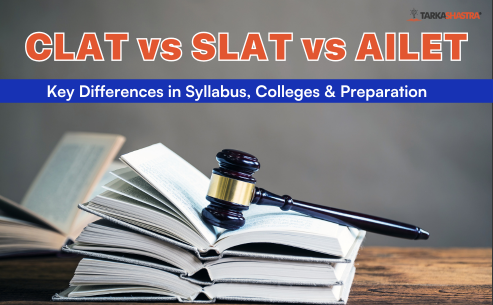Are you (or your child) dreaming of donning a black robe and stepping into a courtroom or corporate boardroom as a top lawyer? A career in law has long been seen as prestigious, versatile, and immensely rewarding. However, with highly competitive entrance exams like the Common Law Admission Test (CLAT), many wonder if the effort is worth it after 12th grade.
To help you make an informed decision, we’re breaking down the relevance of CLAT right after the 12th, the career opportunities it opens up, the financial returns of pursuing an education at National Law Universities (NLUs) like NLSIU Bangalore, NALSAR Hyderabad, and NUJS Kolkata, and how to evaluate whether it’s the best choice for you.
By the end of this blog, you’ll clearly understand what pursuing CLAT offers and whether it’s the right step toward a fulfilling legal career.
Understanding CLAT – The Gateway to NLUs
The Common Law Admission Test (CLAT) is the national-level entrance exam for admission into India’s top law colleges, the National Law Universities (NLUs). These institutions are considered the IITs of legal education. They are known for their academic rigour, global recognition, and excellent placements.
What is CLAT?
CLAT is conducted once a year by the Consortium of NLUs. It tests a student’s aptitude across five areas: English, Current Affairs, Legal Reasoning, Logical Reasoning, and Quantitative Techniques. Successful candidates secure admission into 5-year integrated law programs such as BA LLB, BBA LLB, or B.Com LLB.
Quick Snapshot of CLAT
| Aspect | Details |
| Exam Name | CLAT (Common Law Admission Test) |
| Conducted By | Consortium of NLUs |
| Next Exam Date | 1st December 2025 (Expected) |
| Eligibility | Class 12 appearing/passed students |
| Duration | 2 hours |
| Total Questions | 120 Multiple-Choice Questions |
| Sections Covered | EnglishCurrent AffairsLegal ReasoningLogical ReasoningQuantitative Techniques |
| Mode of Exam | Offline (Pen-and-paper) |
Why NLUs Matter
A good CLAT rank can get your child into India’s most elite law colleges, including:
- NLSIU Bangalore
- NALSAR Hyderabad
- WBNUJS Kolkata
- NLU Delhi (via AILET)
- NLU Jodhpur
- GNLU Gandhinagar
These universities have produced top lawyers, civil servants, judges, policy experts, and corporate leaders. The quality of education, peer groups, internships, and alumni networks available at these NLUs is unparalleled in India.
Is CLAT a Post-Board or Pre-Board Decision?
Many parents assume CLAT prep begins after Class 12 board exams. That’s a mistake. CLAT is a pre-board commitment exam that happens in December, months before Class 12 boards. Early starters (in Class 11) often outperform last-minute aspirants.
Law Career Scope After CLAT
One of the most significant advantages of cracking CLAT and entering a top NLU is the wide range of career opportunities available after graduation. Law is no longer limited to courtrooms today’s law graduates work in corporate boardrooms, global think tanks, fintech startups, and government policy units.
Top Career Options After CLAT
| Career Path | Description | Typical Recruiters / Outcomes |
| Corporate Law | Work with top law firms, handle mergers, contracts, compliance, and legal consulting. | AZB & Partners, Shardul Amarchand, Trilegal, Khaitan |
| Litigation & Judiciary | Practice in trial/high courts or prepare for judicial services (judge exams). | Supreme Court/High Court internships, JSE exams |
| Government & Policy | Join civil services and work in RBI, SEBI, or policy think tanks like NITI Aayog. | UPSC, RBI Legal, Public Policy Fellowships |
| Academia & Research | Pursue LLMs from top universities or become a law professor, policy researcher, or author. | Oxford, Harvard, Indian Law Institute |
| NGOs & International Law | Work in human rights law, international organizations, or global development agencies. | UN, Amnesty, WTO, World Bank |
| LegalTech & Startups | Be part of fast-growing legal startups offering AI-based legal research contract automation. | VakilSearch, LawSikho, ClikLawyer, in-house counsel |
What Makes Law Unique?
- Interdisciplinary: Law intersects with economics, politics, psychology, and technology.
- Dynamic: New fields like cyber law, environmental law, sports law, and fintech law are booming.
- Influential: Law graduates often rise to leadership positions CEOs, MPs, IAS officers, and more.
“A law degree from a top NLU opens doors not just to jobs, but to power, purpose, and prestige.”
Law offers financial rewards and social impact for students with strong reading, reasoning, and articulation skills, a rare combination in today’s job market.
NLU Placement Packages & Salary Insights
One of the biggest reasons CLAT is considered “worth it” is the stellar placement track record of top NLUs. Graduates from colleges like NLSIU Bangalore, NALSAR Hyderabad, and NUJS Kolkata often land high-paying roles in India’s best law firms and multinational corporations.
Average Salary Packages from Top NLUs
| NLU | Average Package (Domestic) | Top Package (Domestic) | International Offers |
| NLSIU Bangalore | ₹16–18 LPA | ₹22–24 LPA | ₹35–40 LPA (select firms) |
| NALSAR Hyderabad | ₹14–16 LPA | ₹18–20 LPA | Up to ₹40 LPA |
| WBNUJS Kolkata | ₹12–15 LPA | ₹18–22 LPA | Rare, but possible |
| NLU Jodhpur, GNLU, NLIU | ₹8–12 LPA | ₹15–18 LPA | Limited |
Note: LPA = Lakhs Per Annum. Figures vary year-on-year and depend on the batch performance and market demand.
Top Recruiters at NLUs
- Law Firms: AZB & Partners, Khaitan & Co., Shardul Amarchand Mangaldas, Trilegal, Cyril Amarchand
- In-House Counsel Roles: Tata, Reliance, HUL, Infosys, Adani Group
- International Firms (rare): Linklaters, Herbert Smith Freehills, Allen & Overy
What Determines Salary Outcomes?
- CLAT Rank → Determines NLU admission
- Law School Performance → Internships, grades, co-curricular
- Networking & Internships → Top firms often offer PPOs (Pre-Placement Offers)
- Soft Skills → Communication, negotiation, and analytical reasoning are critical
“Top NLUs don’t just promise placements—they deliver prestige, high ROI, and a launchpad for elite careers.”
NLUs also offer structured placement cells, alumni mentoring, and tiered internship pipelines that help students secure offers even before graduating.
Return on Investment (ROI): Is CLAT Worth the Money & Effort?
For any career choice, ROI (Return on Investment) is critical—especially for parents investing in coaching, education, and time. When cracked with a good rank, CLAT can lead to a high-value legal education at a fraction of the cost of many private universities or international programs.
Let’s break it down:
Cost of Legal Education at Top NLUs
| Expense Head | Estimated Amount (5 Years Total) |
| Tuition Fees | ₹8–12 Lakhs |
| Hostel & Mess | ₹3–5 Lakhs |
| Books & Supplies | ₹50,000–₹1 Lakh |
| CLAT Coaching (optional) | ₹80,000–₹1.5 Lakhs |
| Total Investment | ₹12–18 Lakhs (approx.) |
Typical Salary After NLU Graduation
| Category | Average Annual Salary | Break-even Period |
| Top Law Firms | ₹15–20 LPA | 1–1.5 years |
| Mid-Tier Firms/In-House | ₹8–12 LPA | 2–3 years |
| Government & Judiciary | ₹6–10 LPA | 3–4 years |
Even in the most conservative estimates, students from top NLUs recover their entire Investment within 2–3 years of graduating.
ROI Highlights
- High Earning Potential: Even freshers earn more than many engineering or commerce grads.
- Low Education Cost: Government-funded NLUs offer quality at lower fees than private universities.
- Prestige Factor: NLU alumni frequently get scholarships for LLMs abroad (saving on future costs).
- Long-Term Career Growth: Many NLU graduates partner in law firms, bureaucrats, judges, or entrepreneurs.
Scholarships and Financial Aid
Most NLUs offer:
- Merit-cum-means scholarships
- State government scholarships for reserved categories
- Fee waivers or deferred payments for economically weaker students
Verdict: If your child gets into a top 5–10 NLU via CLAT, the ROI is among the best in any undergraduate program in India.
CLAT vs Other Career Options After 12th
Parents and students often compare CLAT with other mainstream career paths—like Engineering (via JEE), Commerce (CA/B.Com), or even preparing for Civil Services after graduation. So, where does the law stand in this competitive landscape?
Let’s look at a clear comparison:
Career Comparison Table
| Stream | Entrance Exam | Duration | Top Colleges | Average Salary | Career Flexibility |
| Law | CLAT | 5 years | NLSIU, NALSAR, NUJS, GNLU | ₹12–18 LPA (top NLUs) | High – Corp law, UPSC, NGOs |
| Engineering | JEE Main/Advanced | 4 years | IITs, NITs, IIITs | ₹8–12 LPA (IITs) | Moderate – Tech focused |
| Commerce/CA | CA Foundation/CUET | 3–5 years | SRCC, CA Institutes, NMIMS | ₹6–10 LPA (after CA) | Moderate – Finance/Accounts |
| Civil Services | UPSC (post-grad) | +2–3 years | Any Graduation + UPSC Prep | ₹10–14 LPA (Govt. Pay) | High – Policy, Admin |
| Design/Other | NID, NIFT, etc. | 4 years | NID, NIFT, Pearl Academy | ₹4–8 LPA | Niche – Creative Industries |
What Type of Student Thrives in Law?
CLAT and legal education are best suited for students who are:
- Strong in reading comprehension and analysis
- Curious about current affairs, governance, and society
- Comfortable with structured argumentation and logic
- Looking for influence, leadership, and long-term impact
“Law is the ideal choice for students who want to combine intellectual rigor with real-world power and purpose.”
In contrast to technical or purely academic careers, law offers a blend of logic, language, and leadership—making it an attractive choice for well-rounded students.
Challenges Students Face & How to Overcome Them
Cracking CLAT isn’t just about working hard. It’s about preparing smartly. Students face intense competition, with nearly 60,000+ aspirants competing for just 3,000 seats. But most challenges aren’t academic, they’re strategic.
Common Pitfalls in CLAT Preparation
| Mistake | Impact |
| Ignoring reading habits | Poor comprehension and speed on the exam |
| Over-focusing on board exams | CLAT needs reasoning, not just textbook memorization |
| Skipping mock tests | Lack of time management and real-exam simulation |
| Cramming GK without context | Inability to retain or apply information effectively |
| Studying without a plan | Leads to burnout or underperformance |
“CLAT tests your ability to read, reason, and decide—under time pressure. It’s not a memory game.”
Ideal CLAT Preparation Timeline
| When to Start | Advantage |
| Class 11 | Builds comprehension, habits, and a strong foundation |
| Early Class 12 | Still manageable with a structured plan |
| Post Boards | Risky—only 2–3 months before the CLAT exam |
Innovative Strategies to Overcome These Challenges
- Daily Reading: 1 editorial or legal article per day (The Hindu, LiveLaw)
- Mock Practice: Attempt 1–2 mini mocks/week; analyze mistakes deeply
- Section-Wise Focus:
- English & Legal: Comprehension + Inference
- GK: Legal news, SC judgments, current events (with background)
- Quant: Class 10-level data interpretation, no advanced math
- Guided Mentorship: Weekly review sessions and strategic feedback accelerate growth
With the right mindset and early planning, students can transform CLAT from a challenge into an opportunity.
How Tarkashastra Prepares Students for CLAT Success
At Tarkashastra, we understand that CLAT is not just another entrance test—it’s a career launchpad. Our CLAT program is designed for school students balancing board exams and law entrance prep.
Our focus? Structured learning, personalized mentorship, and parent-student collaboration.
What Makes Tarkashastra Different?
| Feature | How It Helps Students |
| Personalized Study Plans | Tailored to each student’s pace, strengths, and weaknesses. |
| Weekly Mock Tests + Analysis | Build test stamina and learn from mistakes |
| One-on-One Strategy Calls | Regular review sessions with students and parents |
| Reading Habit Development | Editorial tracking, discussion forums, current affairs plans |
| Focused Mentorship & Doubt Clearing | Keep students motivated and accountable |
| Balanced Approach | CLAT + Board exam prep with flexible scheduling |
Our Coaching Formats
| Mode | Ideal For | Advantages |
| Online Classes | Students across India | Flexible timing, access to expert faculty, live + recorded |
| Offline Classes | Pune-based students | Classroom discipline, peer learning, face-to-face support |
| Hybrid Coaching | Students needing custom schedules | Mix of live, self-paced, and mentorship |
“At Tarkashastra, we don’t just teach—we mentor, track, and support your child every step of the way.”
Our goal is not just to help students crack CLAT but to prepare them to thrive in law school and beyond.
Final Verdict: Is CLAT Worth It After the 12th?
So, let’s return to the core question: Is CLAT worth it after Class 12?
If your child is inclined towards reading, reasoning, and leadership—and dreams of a career with impact and income—then CLAT is absolutely worth it.
Why CLAT Is a Smart Career Move:
| Factor | Why It Matters |
| Top NLUs | National recognition, elite peer group, structured academics |
| High Placement Potential | ₹12–20 LPA average packages at Tier-1 NLUs |
| Diverse Career Options | Law firms, policy, civil services, international law |
| Low Education Cost | Government-subsidized legal education |
| Long-Term ROI | Break-even in 1–3 years; exponential career growth ahead |
“CLAT is more than an exam—it’s a launchpad into India’s legal, corporate, and policy-making elite.”
However, early preparation, consistent mentorship, and family support are the keys to unlocking this potential.
If your child starts now—with the right strategy and guidance—the legal journey through CLAT can be one of the most rewarding and future-proof decisions after the 12th.
FAQs – CLAT, Law Career & What Parents Need to Know
Q1. Is CLAT difficult to crack in one year?
Yes, but it’s possible with focused preparation. Ideally, students should start in Class 11, but even Class 12 students can crack it with 8–10 months of smart study, regular mocks, and mentorship.
Q2. Which stream is best for CLAT – Science, Commerce, or Arts?
CLAT is stream-neutral. However, Arts and Commerce students may find the reading and current affairs sections more intuitive. Regardless of stream, strong reasoning and reading skills matter most.
Q3. What if my child doesn’t get into a top NLU?
Good private colleges (like Jindal Global Law School and Symbiosis) and state-level universities exist. Also, CLAT can be reattempted the following year. One exam doesn’t define a career.
Q4. Is coaching necessary for CLAT?
It is not mandatory but highly recommended—especially for busy school students. Coaching helps with structure, feedback, and consistent motivation. Self-study requires intense discipline.
Q5. What is the role of internships in law school?
Internships are crucial. Top firms offer pre-placement offers (PPOs) based on internships. NLUs provide structured internship cycles, often starting from the second year.
Q6. Can law students prepare for UPSC or judiciary later?
Absolutely. Many NLU graduates become IAS/IPS officers or judicial magistrates. Law provides a strong foundation for civil services, RBI, SEBI, and other competitive exams.
Q7. How can parents support their child’s CLAT journey?
- Encourage daily reading and current affairs discussions
- Avoid comparison with JEE/NEET students
- Help them build a routine and reduce distractions
- Choose a coaching partner that offers regular progress updates
Still have questions?
Reach out to Tarkashastra for a free CLAT consultation. Our mentors will help you and your child understand where they stand and how to move forward confidently.







